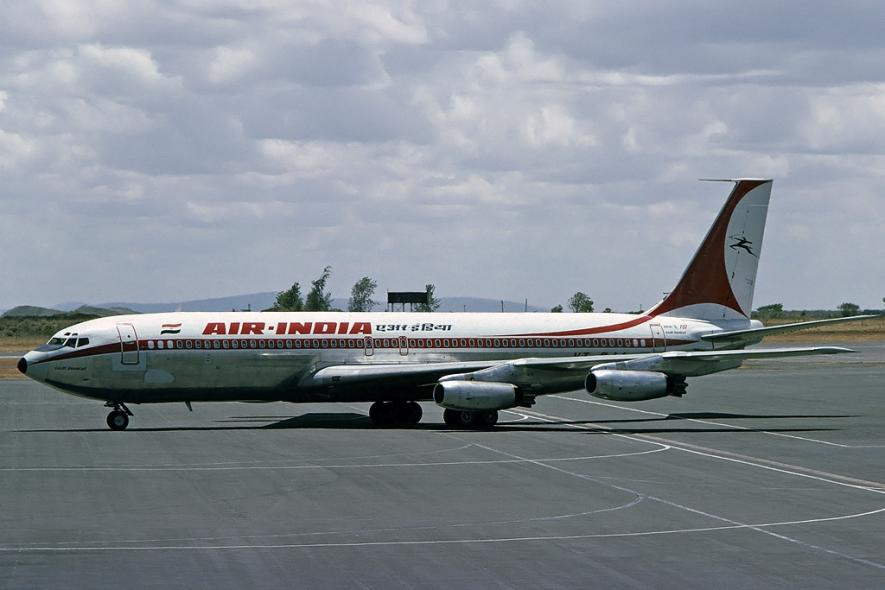Civil Aviation Policy: Subsidize the Rich, Corporates and Foreign Companies

Civil Aviation Policy
It is by now clear that the settled policy framework of the Modi government is to pump in public investment for infrastructure, services, taxes and other incentives for corporates and higher income groups in the belief that this will stimulate further investment especially FDI, wealth creation and GDP growth which will in turn, hopefully and ultimately, trickle down to the less well-off or at least lead to a “feel good” factor. No matter that experience the world over teaches that this only leads to further income disparity, shrinking of real incomes, and shrinking of access by lower income groups to all manners of goods and services. And no matter that such measures are so often advanced in the name of the “common man” whom it certainly will not benefit. Thus land acquisition to benefit industrial houses and real estate magnates was declared to be “pro-farmer,” gentrified and gated “smart cities” are said to promote inclusive urbanization, and bullet trains are said to benefit the average rail passenger.
The recently announced National Civil Aviation Policy (NCAP), much touted for being the first ever policy framed for this sector, is another such contribution. Supposedly in keeping with its promise of being a “comprehensive” policy, NCAP deals with subjects going from “a” to “v”! It is way beyond the scope of this article to deal with all the subjects covered in this long list, and in fact need not do so since many of them, howsoever important, have actually been dealt with in rather a cursory manner, more to show that they were not ignored.
The pink press has been totally taken by the decision to relax the 5/20 rule regulating international services whereby any domestically operating passenger carrier needed to have at least 20 aircraft and 5 years’ operational experience before it was permitted to offer international services. New entrants had been objecting that this prevented a level playing field and favoured older players who would then grab and squat over international permits virtually shutting out newer entrants. This rule has now been modified, with the requirement restricted to the 20 aircraft provision.
However, for this writer, two aspects in the NAPC stand out and are discussed here. First, an explicit commitment to invest State effort and public funds, including subsidies, on expanding the civil aviation customer base and related infrastructure, with the perspective that this will have a multiplier effect on the economy and will benefit the common man. Second, the idea that a set of fiscal, procedural and regulatory incentives will open the floodgates of private sector investment especially FDI into sub-sectors that are not doing well, even though the real reason behind the sluggishness is that, in the face of persistent private sector reluctance and lack of capacity, the State has been and continues to be unwilling to directly apply itself to the task. Two contradictory impulses are at work behind these policy directions, both based on fundamental misconceptions, and neither of which will yield the desired results.
Regional Connectivity
Scheme The big argument in NCAP is that civil aviation has a tremendous multiplier effect on the economy, generating 3.25 times economic growth per unit of investment, and over 6 times the number of jobs compared to average GDP growth, that too especially for “semi-skilled and un-skilled workers” if NCAP is to be believed. It further argues that, if the estimated 300 million strong middle-class buys just 1 air ticket a year, this would mean 300 million passenger-trips per annum compared to the present 70 million, a more than 4-fold increase! The Policy therefore seeks to “take to take flying to the masses by making it affordable and convenient… especially on regional routes” which are currently under-served. Whether this mythical large and expanding Indian middle-class, against whose mythical purchasing power many a multi-national company’s dreams have come crashing, at all exists in the scale imagined is a moot point. Also, by no stretch of the imagination can these or any air passengers be called “the masses.” In any case, NCAP argues that this scenario and potential calls for a massive and rapid expansion in air passenger and cargo traffic, which in turn “will require concessions by the Central and State Governments and Airport Operators.”
Through a new Regional Connectivity Scheme (RCS), the Policy seeks to open up air connectivity to existing non-functional or new airports in small towns and cities on hitherto un-served or under-served regional routes. The Ministry of Civil Aviation (MoCA) would provide subsidy or Viability Gap Funding (VGF) for a “significant part of the capacity” (reports say this could be around 50 percent) of such routes of around 500-600km distance or 1 hour flight with a fare cap of Rs.2500 per seat, apart from a host of other concessions and incentives.
Currently, commercial operations are underway in 75 out of a total of 450 airstrips or airports in the country, some of which are being used for the odd charters, flying clubs or other purposes. RCS seeks to revive and upgrade selected airstrips/ airports on the basis of demand by airlines, with MoCA pledging to meet up to 80 percent of the estimated Rs.50-100 crore cost with State Governments meeting the balance 20 percent, the ratio being 90:10 in case of the North-East, “without insisting on financial viability” (emphasis added). State Governments will be required to provide all necessary land free, levy only 1 percent VAT on aviation fuel, reduce excise duties etc etc.
The subsidy, euphemistically called VGF, would come from a yet-to-be-specified levy on all air passengers on aircraft with all-up weight more than 40 tons which, in the Indian skies, means aircraft larger than the ATR-72 turbo-prop that fly on regional routes.
There are many issues related to whether this scheme will work at all, as discussed below. But the bottom line is that the Government will pay for upgrading new airports, and will subsidize the airlines and passengers by contributing to around half the passengers’ fares and capping them. Corporate circles are overjoyed, airline shares have shot up and the pink press is overwhelmingly congratulatory. That is paradoxical indeed, considering that the corporate sector and pro-liberalization commentators in general have always cried hoarse against subsidies and government “hand-outs,” especially when it comes to the masses, for instance the 90 percent of railway passengers who travel by second-sleeper or lower classes cross-subsidy for whom has long been begrudged as a drag on profitability and the economy. But subsidies for the rich and for private airlines are no problem, and viability of airports is of no concern!
Not workable
However, despite the fond hopes of a State-led and State-subsidized expansion of air passenger traffic, the idea itself will simply not work, ironically because of contemporary market realities.
Of the 75 airports currently in operation, several are already non-viable, have very slim passenger traffic or aircraft movement, and really have little to justify their continued functioning. For example, the once prestigious Mysore airport in Karnataka’s former capital and second city, today has no flights. The public sector Indian Airlines heroically kept up heavily loss-making flights, dwindling to a single flight a week, to Mysore which the Airports Authority of India (AAI) ran at a loss for several years. Vijay Mallya’s Kingfisher too ran some flights to Mysore out of hubris. All to no avail, and Mysore Airport is today shut. So too is the airport at Shimla. Not enough demand, with many alternative modes of travel available, even for the well-heeled passenger. Only state-owned Air India today flies to Kullu a few days a week with an astonishingly high fare of Rs.9,500 for a flight of just over one hour! Can this be subsidized to Rs.2500? Will any subsidy revive Mysore or Shimla airports?
Back in 1994, under so-called Route Dispersal Guidelines (RDG), the pre-merger state-owned monopoly carrier Indian Airlines was ordered to run services on what were then loss-making routes to the North-East, the Islands, J&K and some Tier-II and Tier-III cities. In many cases, these locations were remote, with virtually no other connectivity to the mainland or were considered to be of tourist or strategic importance such as Jaipur, Agra or Bagdogra. These services were cross-subsidized by 12 trunk routes connecting the metros and major cities, a subject of much recrimination especially after passenger air services were opened to the private sector. NCAP acknowledges the contribution made by this policy or yester-years but makes no comment about the derisory remarks made about the policy including in government documents! Today, many of these routes have vindicated the decision to cross-subsidize them, and have multiple daily flights including by private airlines with no need for subsidy, major airports in the North-East having over 2,000 daily passenger movements. But will the same apply to airports other than these?
Of the current 75 operational airports, around 25 even today cater to less than 250 passenger movements (in-coming and out-going together) per day, or roughly 3-4 aircraft movements daily! And this includes large or prominent locations such as Khajuraho, Allahabad, Gorakhpur, Gwalior, Agra and Kanpur. Fact of the matter is that the demand is limited, other convenient and affordable means of transport are available and subsidies are either not needed or will make no sense.
It is highly doubtful if a credible list of locations could be drawn up that are so remote or so strategically located that they need or can justify the Regional Connectivity Scheme drawn up under the NCAP? Or is this just wishful thinking, or will they be just vanity projects favoured by Chief Ministers or local MPs or other VIPs? Unlike the RDGs of yore, there is unlikely to be sound justification for any significant list of deserving airports or routes. And even if subsidy were to be given, they would be very unlikely to justify themselves a few years down the line.
So here is a case of the State going out of its way to subsidize transport services for the better-off, going against the prevailing market-governed wisdom, with little justification in terms of objective criteria and fewer rewards even in the long run.
Other Policies
NCAP offers just the opposite in other policies it puts forward. Instead of the State stepping up and taking initiative because the private sector can or will not, it prefers to sit and watch and hope that somebody will do something!
Two policy measures will illustrate this.
NCAP claims it will further the Modi government’s favourite “Make in India” goal by declaring MoCA as the nodal Ministry for aeronautical manufacturing, without any capability in this area which the Ministry of Industry and PSUs, for example, would have. One way suggested is to join hands with Ministry of Defence (MoD) to facilitate use of offsets on military purchases in civil aircraft manufacturer. But this has precisely been used by OEMs of military hardware as a ruse to escape from parting with defence technology! MoCA would also encourage foreign OEMs to set up manufacturing bases in India and declaring these as SEZ. This is MoCA following the lead of MoD, not wanting to encourage indigenous manufacture and capacity-building but facilitating foreign manufacturers to penetrate or even take over the Indian market. For good measure, NCAP adds that “in case the cost of made-in-India aircraft and components work out to be higher than those supplied from their original sources, the government will consider an incentive package to nullify the cost differential”! In other words, subsidize the foreign OEMs!!
NCAP puts forward a series of incentives, easing of procedures and regulatory measures to facilitate Maintenance, Repair and Overhaul (MRO) services in India. Today, despite having a fleet of over 500 civilian aircraft with a projected fleet strength of over 1,600 by 2030, India sends around 90 percent of its aircraft overseas for repairs, servicing and overhaul, due to not having adequate MRO facilities in either public or private sectors. As argued in other contexts in these columns, the private sector in India has never shown the gumption to set up MRO facilities in India despite the huge potential demand, because of both lack of capability and lack of courage. Sadly, neither has the pubic sector, whereas Air India, Indian Airlines, Hindustan Aeronautics Ltd or the Airports Authority of India could have set up subsidiaries exclusively for the purpose. Our tiny neighbour, Sri Lanka, today services many of India’s large private sector fleets through an MRO subsidiary of its national carrier SriLankan Airlines! NCAP could have seized this opportunity to strongly pushed for setting up a domestic MRO that could have not only tapped into the large domestic demand but also catered to foreign airlines. But no! Having declared itself the “nodal agency” for “aeronautical make in India,” MoCA tamely offers only to invite foreign OEMs or tinkers with procedures, instead of stepping up and picking up the burden itself. This fully reflects the philosophy of the NCAP: subsidize the rich, the corporates and foreign players.
Cover Image Courtesy: en.wikipedia.org
Disclaimer: The views expressed here are the author's personal views, and do not necessarily represent the views of Newsclick
Get the latest reports & analysis with people's perspective on Protests, movements & deep analytical videos, discussions of the current affairs in your Telegram app. Subscribe to NewsClick's Telegram channel & get Real-Time updates on stories, as they get published on our website.
























